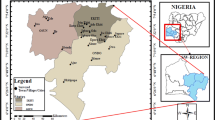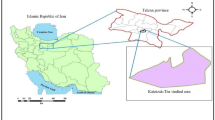Abstract
Radon is a radioactive gas formed in the decay chains of uranium and thorium. Uranium and thorium are natural radionuclides that are ever present in the Earth’s crust, which form the raw materials of the building. Being radioactive, radon and its progenies emit high-energy alpha particles hence becoming the main percentage contributor to natural background radiation to humans. Thus, this research is focused on the background radiation exposures due to indoor irradiation as an effort to record the preliminary data on radiological risk to the population in UiTM Jengka. Assessment of indoor radon concentration and annual effective dose at selected buildings in UiTM Jengka have been recorded since no such data is available, which started the establishment of the campus in 1993. Assessment of indoor radon concentration and annual effective dose at selected buildings UiTM Jengka was carried out by using solid-state nuclear track detector (CR-39). The radon track detectors were left for about a month in selected buildings and places frequented and occupied by students and staff of UiTM Pahang. The track detectors were then etched and analyzed to determine the radon concentration of the selected location. The range of the indoor radon concentration for all places was 7.42–30.12 Bqm−3 with an average of 15.80 ± 8.66 Bqm−3. The average annual effective dose was found to be 0.40 ± 0.22 mSvy−1 and varies from 0.19 to 0.76 mSvy−1. Whereas the excess lifetime cancer risk (ELCR) UiTM Jengka was found to vary from 0.07 to 0.29%. A building that represented residential, college, classroom, office, and laboratory being below the permissible limit for average indoor radon concentration is about 48 Bqm−3, the world’s average annual effective was 3–10 mSvy−1 and ELCR limit is 1.3%, respectively. The results indicated that radiological risk is due to radon in this study area is considered safe.
Access this chapter
Tax calculation will be finalised at checkout
Purchases are for personal use only
Similar content being viewed by others
References
Al- Saleh FS (2007) Measurements of indoor gamma radiation and radon concentrations in dwellings of Riyah city, Saudi Arabia. Appl Radiat Isotopes 65(7):843–848
Amin RM (2015) Asessesment of concentration and exposure doses due to radon by using CR-39 plastic track detectors in the dwellings of Saudi Arabia. Adv Appl Sci Res 6(7):42–48
Baeza A, Garcia-Paniagua J, Guillen J, Montalban B (2018) Influence of architectural style on indoor radon concentration in a radon prone area: a case study. Sci Total Environ 610:258–266
Battawy AA, Tawfiq NF, Najam LA, Jaafar MS, Mustafa IS (2016). Indoor radom concentration measurement in different iraq radiation locations, IX (1):1–7
Borgoni R, De Francesco D, De Bartolo D, Tzavidis N (2014) Hierarchical modelling of indoor radon concentration: how much do geology and building factors matter? J Environ Radioact 138:227–237
Gandolfo G, Lepore L, Pepperosa A, Remetti R, Franci D (2017) Radiation protection considerations on radon and building materials radioactivity in Near Zero Energy Buildings. Energy Procedia 140:13–22
Harb S (2015) Measurements level of Radon-222 in some houses by using SSNTDs in Qena city. Egypt 1:19–23
ICRP (2010) International Commission on Radiological Protection. Lung cancer risk from radon and progeny and statement on radon. Annals of ICRP (ICRP Publication 114): 23–24
Kandari T, Aswal S, Prakash M, Bouri AA, Ramola R (2015) Estimation of annual effective dose from radon concentration along Main Boundary Thrust (MBT) in Garhwal Himalaya. J Radiat Res Appl Sci 9(3):228–233
Khan MSA, Tariq M, Rawat RBS (2012) Preliminary measurements of radon radiations in ‘Bare Mode’ in Rampur District of Western UP (India). IOSR J Appl Phys 1(4):4
Lee SK, Wagiran H, Ramli AT, Apriantoro NH, Wood (2009) Radiological monitoring: terrestrial natural radionuclides in Kinta District, Perak, Malaysia. J Environ Radioact 100(5):368–374
Lu X, Chao S, Yang F (2014) Determination of natural radioactivity and associated radiation hazard in building materials used in Weinan, China. Radiat Phys Chem 99:62–67
Maged AF, Ashraf FA (2005) Radon exhalation rate of some building materials used in Egypt. Environ Geochem Health 27(5–6):485–489
Matiullah FM, Muhammad R (2012) Indoor radon monitoring near an in situ leach mining site in D G Khan, Pakistan. J Radiol Prot 32:427–437
Pillai GS, Hameed PS, Chandrasekaran S, Sivasubramanian K, Baskaran R, Venkatraman B (2017) Indoor radon (222Rn) and thoron (220Rn) measurements and assessment of human risk in the dwellings of Tiruchirappalli city (Tamil Nadu, India). Chem Data Collect 9:197–207
Qureshi AA, Tariq S, Din K, Manzoor S, Calligaris C, Waheed A (2014) Evaluation of excessive lifetime cancer risk due to natural radioactivity in the rivers sediments of Northern Pakistan. J Radiarion Res Appl Sci 7(4):438–447
Ramli AT, Hussien AWM, Wood AK (2005) Environmental 238U and 232Th concentration measurements in an area of high level natural background radiation at Palong, Johor, Malaysia. J Environ Radioact 80(3):287–304
Rana MA (2012) Swelling and structure of radiation induced near-surface damage in CR-39 and its chemical etching. Radiaton Meas 47(1):50–56
Rubin P, Casarett GW (1968) Clinical radiation pathology as applied to curative radiotheraphy. Cancer 22(4):767–778
Sha Z, Iskandar SM, Azhar AR, Suhaimi M, Lina R, Halimah M (2014) UV-VIS Spectral evaluation of CR-39 detector exposed with diagnostic dosage. Sains Malaysiana 43(6):953–958
Sherafat S, Mansour SN, Mosaferi M, Aminisani N, Yousefi Z, Maleki S (2019) First indoor radon mapping and assessment excess lifetime cancer risk in Iran. MethodsX 6:2205–2216
Takada M, Kamada S, Yajima K, Iwaoka K, Enomoto H, Tabe H, Sugiura N (2014) Measurement of radiation environment inside residential houses in radioactive contaminated areas due to the Fukhushima nuclear accident. Prog Nuclear Sci Technol 4:43–46
Tawfiq NFR, Noora OA, Asmaa A (2015) Measurement of indoor Radon Concentration in various dwellings of Baghdad. Iraq 3(5):202–207
UNSCEAR (2000a) Radiation sources and Effects of ionizing radiation (New York: USA: United Nations. Report of the United Scientific Committee on the Effect of Atomic Radiation to General Assembly), pp 84–85
UNSCEAR (2000b) United nations scientific committee on the effects of atomic radiations. Report to the general assembly. Sources and effects of ionizing radiation, United nations, New York, 2000b, vol I, pp 92–93
WHO (2009) World health organization. A public health perspective, WHO Press, Geneva, WHO handbook on indoor radon
Acknowledgements
The author acknowledged the support provided by the residents of the study area during the fieldwork at Universiti Teknologi MARA Cawangan Pahang and providing facilities for analysis at Universiti Teknologi MARA Shah Alam.
Author information
Authors and Affiliations
Corresponding author
Editor information
Editors and Affiliations
Rights and permissions
Copyright information
© 2022 Springer Nature Singapore Pte Ltd.
About this paper
Cite this paper
Zainuddin, N.S. et al. (2022). Radon Gas Assessment of Selected Buildings at Universiti Teknologi MARA Jengka, Pahang, Malaysia. In: Yacob, N.A., Tholibon, D.A., Mohd Yunus, N.Y., Jamil, Z., Mohd Tahir, S. (eds) Fundamental and Applied Sciences in Asia. Springer, Singapore. https://doi.org/10.1007/978-981-19-4910-4_7
Download citation
DOI: https://doi.org/10.1007/978-981-19-4910-4_7
Published:
Publisher Name: Springer, Singapore
Print ISBN: 978-981-19-4909-8
Online ISBN: 978-981-19-4910-4
eBook Packages: Social SciencesSocial Sciences (R0)




